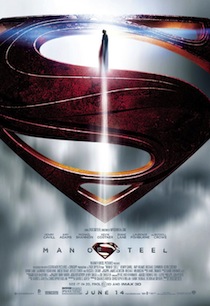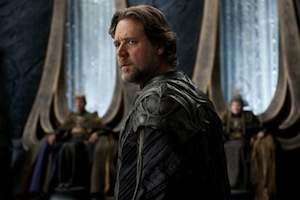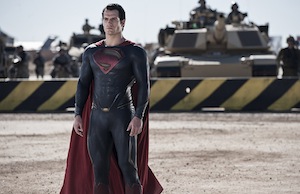 Contrary to popular belief, Superman isn’t a difficult character to make compelling. Sure, he has no weaknesses and his abilities make him a God. But he’s a character in constant conflict. He’s beholden to Earth, but he’s not from here. His attempts to rally humankind behind his example, his efforts are often met with fear and doubt from humans and often fail completely. He looks like us, but isn’t one of us. And unlike other heroes, his alter-ego is human, not hero. The character is deeper than he seems at first glance, but considering the spit-curled boy scout we’ve seen in the original Christopher Reeves films or even the Max Fleischer cartoons, it’s understandable that the “truth, justice and the American way” Superman is the only version to many.
Contrary to popular belief, Superman isn’t a difficult character to make compelling. Sure, he has no weaknesses and his abilities make him a God. But he’s a character in constant conflict. He’s beholden to Earth, but he’s not from here. His attempts to rally humankind behind his example, his efforts are often met with fear and doubt from humans and often fail completely. He looks like us, but isn’t one of us. And unlike other heroes, his alter-ego is human, not hero. The character is deeper than he seems at first glance, but considering the spit-curled boy scout we’ve seen in the original Christopher Reeves films or even the Max Fleischer cartoons, it’s understandable that the “truth, justice and the American way” Superman is the only version to many.
Enter Zach Snyder and David S. Goyer‘s interpretation of Kal-El and his legacy with Man Of Steel. The summer blockbuster splits the difference between big budget bombast and character study, telling the story of the demise of Krypton, the culture of that planet, the Earth parents who would shape the Krypton’s lone survivor and the boy who would grow up to be the most powerful hero on the planet. That’s quite a breadth of storytelling, so it’s no surprise that Man Of Steel is nearly 150 minutes long.
What is a surprise is that Man Of Steel showcases Snyder at his most restrained. Gone is the much of the gratuity of Watchmen or 300 and instead we’re given a a more focused, steady movie that tells its story directly. Both an origin story for Superman and his planet, the movie opens on a re-imagined Krypton in the throes of a military coups led by Michael Shannon as General Zod. Russell Crowe plays Jor-El, a well-meaning scientist who has warned of his planet’s destruction, and is now faced with its impending doom. Naturally, he sends his only begotten son across the stars to spare him from the planet’s end.
The first 15 minutes says everything you need to know about Man Of Steel. It’s fast-paced, full of questionable art and costume design with a color palette borrowed from The Dark Knight trilogy, and punctuated by Hans Zimmer‘s score, which tries to out “John Williams” John Williams. Along with some very Avatar-esque alien fauna, there’s some very phallic-obsessed architects on Krypton.
Anyway, once Kal-El is on Earth, Man Of Steel focuses on his life as Clark Kent, cutting to his life of secrecy, which involves laying low, roaming the country and doing a lot of manual labor. This decision actually makes sense and is one of the movie’s strongest elements. While so many first chapter superhero movie follows a similar plot structure wherein the protagonist goes from normal to super, comes to grips with his or her new powers and then stops the antagonist, Superman is already super. Snyder and Goyer’s decision to parse out Kent’s backstory through flashbacks actually works quite well.
Another strong moment in Man Of Steel comes when Superman faces off against Zod’s forces for the first time. There are only so many directors who can make a tight action sequence also a strong plot point, where our hero learns something about himself and the audience becomes further endeared with his struggle. When Snyder is on his best behavior, Man Of Steel does an excellent job of keeping things moving without sacrificing characterization in the process.
 The problems arise when he slips into old habits. Man Of Steel is packed full of action, and with the PG-13 rating and a hero that is nigh indestructible, it gives Snyder free reign to escalate the fight scenes to the appropriately exaggerated proportions. But that also means flying in the face of a lot of the preserving of human life that Superman kind of, sort of, totally stands for. This is especially true of the film’s climax, which sees a city decimated and untold, faceless thousands killed in the wake of a superhero sparring match. He also gives us a Superman that will cross boundaries other versions of the character haven’t typically crossed in the past.
The problems arise when he slips into old habits. Man Of Steel is packed full of action, and with the PG-13 rating and a hero that is nigh indestructible, it gives Snyder free reign to escalate the fight scenes to the appropriately exaggerated proportions. But that also means flying in the face of a lot of the preserving of human life that Superman kind of, sort of, totally stands for. This is especially true of the film’s climax, which sees a city decimated and untold, faceless thousands killed in the wake of a superhero sparring match. He also gives us a Superman that will cross boundaries other versions of the character haven’t typically crossed in the past.
At it’s best, Man Of Steel does an amiable job of updating and deepening the Superman mythos for the modern age. It accomplishes this by telling its own story and playing with archetypes we’ve seen for awhile. When Snyder is composed and focused, he delivers his strongest movie to date.
When he slips into old habits, or when the movie tries to insert so many last-minute character tropes, the movie becomes a lumbering, bludgeoning chore. If there had been just a little more of the former and less of the latter, it could have been fantastic. As it is, Man Of Steel is merely serviceable.




{ 2 comments }
Watching this movie was a lot like being really attracted to a hot girl until you find out she gave your buddy herpes…
Not exactly how I’d put it, but I suppose the allegory works. Which part of ‘Man of Steel’ gave your buddy herpes?
Comments on this entry are closed.